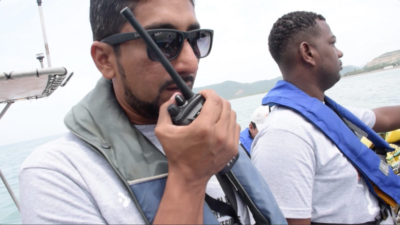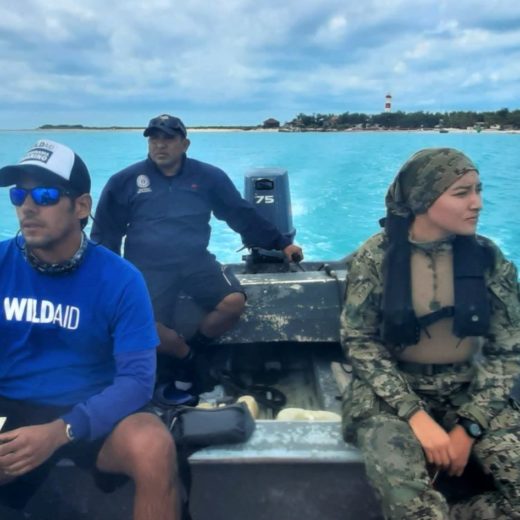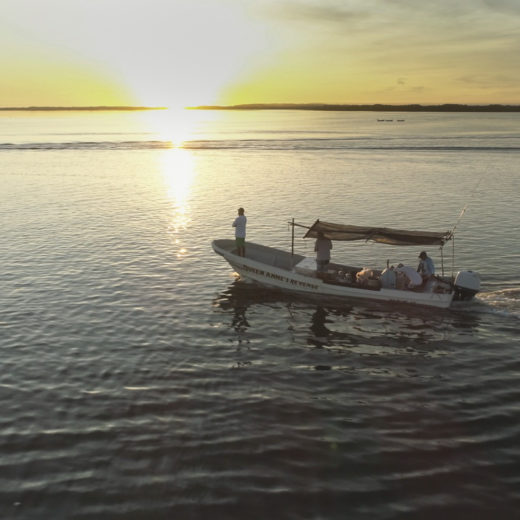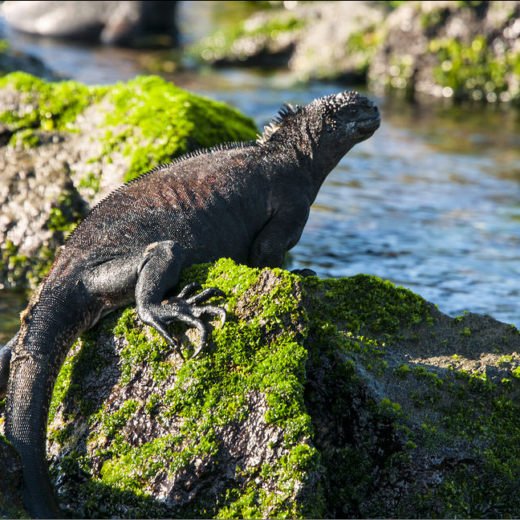
BY SILVIA SANCHEZ BOR, WILDAID MARINE PROGRAM
Communications, command and control (C3) models are used throughout the U.S. armed forces to ensure mission objectives. This assures situational awareness and getting critical information to the right users at the right time. At WildAid, we’ve adapted these principles to the marinescape with the dual goal of protecting precious fisheries and Park Wardens, as exemplified by the following scenario.
A small artisanal boat is moored in a popular local fishing spot in the Santa Elena Wildlife Refuge when two divers emerge with bags full of their catch. Upon inspection, the Santa Elena Rangers find illegally caught sea cucumber mixed with the rest of the catch. Faced with the threat of seizure, the fishers and boat captain become aggressive… Now what?
Most would expect the rangers to radio their control center to report the situation and request backup; However, up until recently, the Rangers did not have a reliable means of communication often relying on personal cell phones with limited reception.
With funding from the Stellar Blue Fund, WildAid supported the marine parks of Pacoche, Santa Elena and El Morro in the procurement of reliable communication equipment and the systematic training of Rangers in maritime operations. As most Rangers are trained in biology rather than enforcement operations, they lack the basic tactical skills and training to avoid the dangers associated with fisheries law enforcement. Compounding issues, many are often ill-equipped to perform their duties.
Since its installation, the communication system combined with specialized Ranger training has been a success in field operations at all three sites. In El Morro, Rangers now report feeling safer during patrols knowing that they can communicate at will with their control center as well as with the Navy. Contraband, fuel and drug trafficking are ubiquitous throughout coastal areas of Ecuador and a simple boarding of an unsuspecting vessel can quickly go wrong. With reliable communications, Rangers are also able to communicate from a distance with suspicious vessels to avoid dangerous encounters with armed fishers or traffickers.
In Pacoche, where patrols are severely limited by fuel costs and its large geographic area, the radios allow rangers more flexibility to conduct targeted patrols and interceptions. Rangers conducting beach patrols communicate with rangers at sea when they spot fishing vessels or other suspicious activity from shore, thus allowing the patrol boat to quickly intercept illegal fishing activities and prevent fuel waste.
Likewise, in Santa Elena, the communication system allows rangers to quickly gather information about the fishers they’ve intercepted by reporting fishing and boat license information to the control center as well as inform their colleagues to prepare for an arrest.
This work is part of a three-year project in Ecuador to reduce illegal fishing in six of its coastal marine protected areas. We are grateful for the support of the Sandler Foundation, Conservation International, the Walton Family Foundation, the Overbrook Foundation and the Steller Blue Fund in decreasing illegal fishing along Ecuador’s coast since 2014.
Español
Un Nuevo Sistema de Comunicación Para Ecuador
Una lancha pequeña se encuentra en un sitio popular de pesca dentro La Reserva Marino Costera Puntilla de Santa Elena (REMACOPSE) cuando dos buzos salen del agua con bolsas llena de pesca. Dado una inspección, los guardaparques encuentran pepino de mar mezclado con la pesca. Los pescadores y el capitán se ponen agresivos con la amenaza de una detención. ¿Ahora que se hace?
La expectativa es que los guardaparques llamen por radio a su centro de control para reportar la situación y pedir ayuda adicional. Sin embargo, hasta recientemente, los guardaparques no tenían métodos de comunicación de confianza y frecuentemente utilizaban sus celulares personales con recepción limitada.
Con fondos del Stellar Blue Fund, WildAid adaptó principios militares para asegurar comunicación confiable y la capacitación de guardaparques para situaciones como la previa. Recientemente, compramos e instalamos un sistema de radio VHF para las áreas marinas protegidas de Pacoche, Santa Elena y El Morro y proveímos un taller de capacitación en operaciones marítimas. Como muchos de los guardaparques tienen entrenamiento en biología, los temas de estrategias tácticas requeridas en un ámbito marino se enfatizaron durante el taller.
Desde su instalación, el sistema de comunicación combinado con la capacitación ha sido un éxito en las operaciones de los tres sitios. En El Morro, los guardaparques reportan un sentido de seguridad durante sus patrullas sabiendo que se pueden comunicar con su centro de control y la Armada. El contrabando y el tráfico de drogas y combustible son frecuentes ocurrencias en las áreas costeras de Ecuador y un abordaje sencillo puede tener varios peligros. Con este método de comunicación, los guardaparques también se pueden comunicar a una distancia con las embarcaciones para prevenir encuentros peligrosos.
En Pacoche, donde las patrullas se limitan por costos asociados por el combustible y su área geográfica, los radios permiten flexibilidad en conducir patrullas dirigidas e intercepciones. Los guardaparques en la playa se pueden comunicar con los guardaparques en el mar cuando ven a lanchas de pesca u otras actividades sospechosas, permitiendo que la embarcación de patrulla intercepte a las actividades de pesca ilegal y prevenir el desperdicio de combustible.
Igualmente, en Santa Elena, el sistema de comunicación permite que los guardaparques recolecten información rápidamente acerca los pescadores que interceptan con la coordinación con su centro de control y también pueden informarles a sus colegas de las detenciones.
Este trabajo es parte de un proyecto de tres años para reducir la pesca ilegal en Ecuador en seis de sus áreas marinas protegidas. Apreciamos el apoyo de Sandler Foundation, Conservation International, Walton Family Foundation, Overbrook Foundation y el Steller Blue Fund en este trabajo desde el 2014.
Stay in touch and get the latest WildAid updates.
SIGN UP


